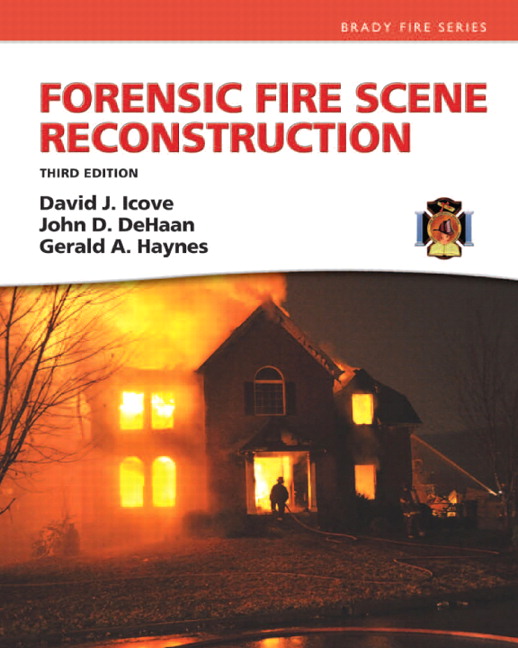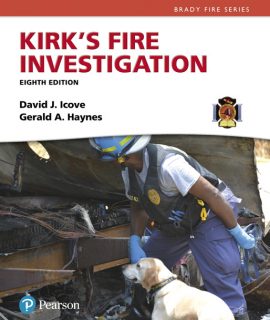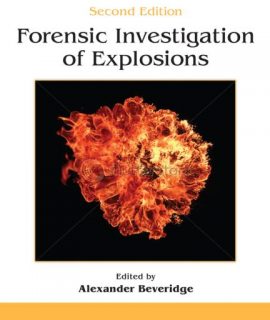Forensic Fire Scene Reconstruction, 3rd Edition
$158.35
Forensic Fire Scene Reconstruction, Third Edition, describes and illustrates a new systematic approach for reconstructing fire scenes, applying the principles of fire protection engineering along with those of forensic science and behavioral science.
Modern fire investigation topics are covered, including comprehensive documentation, hypothesis testing, and defensible reconstruction of the events leading up to the fire and its final results.
Using historical fire cases and realistic case examples, the authors examine the newest lessons learned and insight into the ignition, growth, development, and outcome of those fires.
All documentation in the case examples follows or exceeds the methodology set forth by the NFPA in NFPA 921–Guide for Fire and Explosion Investigations and its companion standard NFPA 1033–Standard for Professional Qualifications for Fire Investigator, 2009 Edition, and Kirk’s Fire Investigation ,Seventh Edition.
Features:
Describes a systematic approach to reconstructing fire scenes in which investigators rely on the combined principles of fire protection engineering along with forensic and behavioral science.
* Using this approach, the investigator can more accurately document a structural fire’s origin, intensity, growth, direction of travel, and duration as well as the behavior of the occupants.
* Provides the investigator with a firm understanding of the phenomenon of fire, heat release rates of common materials, heat transfer, growth and development, fire plumes, and enclosure fires.
Describes the underpinnings of how fire patterns are produced and how they can be used by investigators in assessing fire damage and determining a fire’s origin.
* Fire patterns are often the only remaining visible evidence after a fire is extinguished. The ability to document and interpret fire pattern damage accurately is a skill of paramount importance to investigators when they are reconstructing fire scenes.
Details the systematic approach needed to support forensic analysis and reports.
* Thorough documentation is the only means of providing reliable data on which the investigator can apply the scientific method of analysis that the courts demand today. The purpose of forensic fire scene documentation includes recording visual observations, emphasizing fire development characteristics, and authenticating and protecting physical evidence. The underlying theme is that thorough documentation produces sound investigations and courtroom presentations.
* Includes commentaries on new technologies useful in improving the accuracy and comprehensiveness of documentation.
Reviews the techniques used in the analysis of arsonists’ motives and intents.
* Presents nationally accepted motive-based classification guidelines along with case examples of the crimes of vandalism, excitement, revenge, crime concealment, and arson-for-profit. The geography of serial arson is also examined, along with techniques for profiling the targets selected by arsonists.
Discusses the use of various mathematical, physical, and computer-assisted techniques for modeling fires, explosions, and the movement of people.
* Such modeling is necessary as a means of demonstrating that the opinions of the investigator have been thoroughly tested as alternative hypotheses are developed and considered.
* Numerous models are explored, along with their strengths and weaknesses. Several case examples are also presented.
Provides an in-depth examination of the impact and tenability of fires on humans.
* The chapter examines what kills people in fires, particularly their exposure to by-products of combustion, toxic gases, and heat.
* Examines the predictable fire burn pattern damage inflicted on human bodies and summarizes postmortem tests and forensic examinations desirable in comprehensive death investigations.
* The latest in published data on post-mortem effects of fire on human bodies is now included for the use of fire and medicolegal experts in fire death cases.
Reviews the applicable standard fire testing methods that are important to forensic fire scene analysis and reconstruction.
* These range from bench top “lab” tests to full-scale fire reconstructions of varying complexity.
* The usefulness and limitations of the whole range of fire tests are described so that investigators can chose the most appropriate ones.
Contains an epilogue written by an experienced career firefighter and attorney.
* The epilogue traces the past, present, and future impact of how fire scenes need to be visualized and documented in three-dimensions in order to truly capture the impact of fire patterns in determining origin and cause of fires.
New to this Edition:
Fully updated and streamlined from the previous edition, the third edition offers the latest information on investigative technologies and innovative documentation techniques.
* Meets the FESHE guidelines for fire investigation, with correlations to NFPA 921 and NFPA 1033.
* Includes the latest information on applying the scientific method to fire investigations.
* Nearly all photos are now in color, making interpretation by the reader easier.
* Updated, in-depth case examples demonstrate the use of forensic fire engineering analysis approaches.
* Comprehensive glossary provides the latest definitions of common forensic fire investigation terminologies.
New MyFireKit solution provides specific online resources for both students and instructors.
* Provides the essential information required in preparing for the International Association of Arson Investigator’s (IAAI) Fire Investigation Technician (IAAI-FIT) and Evidence Collection Technician (IAAI-ECT) Examinations.
Categories
- Firehall Mall
- First Alert Smoke & Carbon Monoxide Alarms
- Coming Soon – Pre-Order
- ATS Online Training
- NFPA Standards & Fire Codes
- Ontario Codes
- Fire Safety & Public Education Materials
- Fire Service & Rescue
- Fire Investigator
- Fire Inspection & Code Enforcement
- Apparatus Driver/Operator
- Fire Protection/Systems & Apparatus
- Vehicle Extrication/Highway Safety
- Hazardous Materials
- Industrial / Facility
- Building & Life Safety
- Fitness / Wellness / Health & Safety
- Wildland
- Management / Leadership / Advancement
- Firefighter Entry Level
- Emergency Medical Service
- Emergency Management/Terrorism
- Firefighting Novels/History/Memoirs
- Deals & Steals






